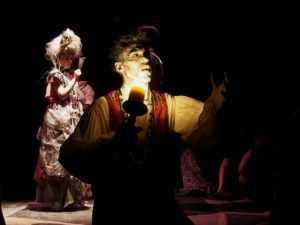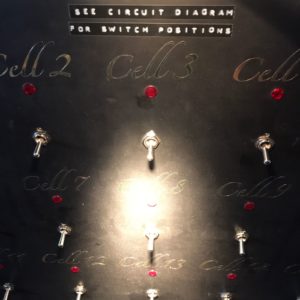We’re immersive lighting designers – it says so under our name. Whether it’s immersive theatre, dining or some other new-fangled experiential thing, we’ve lit all sorts. In fact, we’ve just finished work on The Great Masked Ball – a beautiful immersive performance of Swan Lake.
During The Great Masked Ball and other immersive projects, we’ve worked out a few tricks to lighting adventures through unusual spaces. Keeping sets sparkling, actors lit, and audience members able to see afterwards might seem tricky. But with any luck our secrets might just help pull it off…
1. Don’t make lighting an afterthought!
Immersive experiences are essentially collaborative. The lighting designer should be part of the design process and vice versa. To give an environment the right feel, you need to consider all lighting elements from the outset.
This is also handy for practical reasons. It gives you the ability to hide cables, install fixtures discreetly within the set and saves time on the installation (and therefore money!).
2. Use practicals to take the audience on a journey
If you’re unsure what ‘practicals’ are, we’re talking light props! Pieces performers can use that will also help light a scene. Lanterns, candles, wands – anything that glows can really carry the action and pull the audience’s focus.
Performers can also use practicals to light themselves. This reduces the number of overall lighting fixtures needed, keeping performers visible as they roam throughout spaces.
3. Keep things natural.
Lighting needs to compliment the set and not feel intrusive. It should make an audience feel more immersed, not distract them.
But what if you need to focus the audience’s attention on a particular feature in the space to help carry the story?! Then add in fixtures for this purpose and program in any lighting changes you need.
Even when you’re recreating naturally lit spaces, focus the light so it doesn’t bounce everywhere. Too many reflections will flatten everything out and leave it feeling a bit clinical. Eugh. Also – and this is one of our absolute best super top secret tips – try playing with shadows to create some interesting textures.
4. Accept that sometimes you can’t avoid shining light in people’s eyes, but be clever about it.
It’s immersive performance. You’re putting an audience inside a set, and then bringing in performers. These performers may need to be well lit for the scene. Unfortunately, you’re pretty much guaranteed to spill light in at least somebody’s eyes. Fortunately, we’re here to tell you that that’s ok. Just build the light into the experience – whether as a practical or hidden within something else.
Immersive events are often ‘in the round’, with audience members positioned all around the action. This forces creativity (it’s also a bit of a nightmare – sometimes I wonder if I chose the wrong profession…).
But the point is, you need to be inventive with how you light people. Take the traditional rules and turn them on their head. For example, if your audience is low down, you can light across the space. This might just mean they leave with their vision intact.
5. Treat daylight scenes with caution!
Sadly, it’s impossible to avoid daylight scenes completely. The designer of your immersive experience might need a scene that takes place in brilliant clear daylight (and commonly for us in something resembling a 6’x6′ box… argh!). If this is the case, you’ll just have to get good at it.
Understand that daylight is made up of multiple light sources with very different colour temperatures. The sun is visible to us at around 3500 Kelvin. But a clear blue sky is closer to 7000 Kelvin. These temperatures combine to make up the light conditions we see in the outside world. Have I lost you yet? This might help.
Of course, it’s far easier to take the experience outside into actual daylight. But then I’d be out of a job…
6. Give art department a hug.
Scenic painters love to do their thing in light reminiscent of the final look of the experience. It doesn’t need to be 100% perfect. But the wonderful artists we’ve worked appreciated working in conditions similar to the final space.
This means they know their hard work isn’t going to be washed out or distorted in its final setting. Help them do their job and they will love you forever.
To use an extreme example – you wouldn’t want to paint a UV portrait in non-UV light. You’d be working blind!
7. Make it fun and interactive!
Immersive experiences are all about engaging audience members as much as possible. Interactive elements are brilliant for that.
There’s a range of kit available that can give the audience control of the lighting and other elements in a space. That said, it can sometimes be a bit tricky to get everything to work together reliably. When I can’t find the controls I’m after, I normally ask my technical guys to make something up. Which is luckily something they’re brilliant at.
Here’s a couple of ideas to try: use game-show style buzzers that control everything in a room. Or, a bit trickier – try pressure sensors that react to the audience’s movement and encourage participation (you can see some this stuff in our work on Chambers of Flavour v2).













